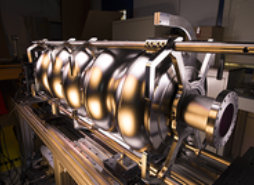
"Dirty'' Superconductors can make better particle accelerators
August 30, 2019
With quality factors exceeding 2 x 10^11, Niobium SRF cavities are the technology of choice for converting electromagnetic energy into high-energy charged particle beams. Applications range from particle collider experiments to unconver the fundamental laws of sub-atomic structure, atomic and molecular structure of condensed matter, to structural studies of biological materials for applications in biology and medicine.
A new theoretical study, based on the microscopic theory of superconductivity extended to incorporate the effects of an impurity diffusion layer, identifies a key mechanism that can lead to increases in the maximum accelerating field of superconducting radio-frequency (SRF) cavities for particle accelerators. Infusing impurities into the surface of the superconductor increases the volume of the superconducting screening currents without reaching the critical current at which superconductivity is destroyed. The research highlights how a deeper understanding of the fundamental properties of superconductors operating near the limit of stability can provide pathways to the future development of next-generation particle accelerators.
The paper is published as a Rapid Communication in the inaugural issue of the American Physical Societies' Open Access journal Physical Review Research:
Effect of inhomogeneous surface disorder on the superheating field of superconducting RF cavities
Vudtiwat Ngampruetikorn and J. A. Sauls
Phys. Rev. Research 1, 012015(R) (2019) – Published 29 August 2019
doi: 10.1103/PhysRevResearch.1.012015
